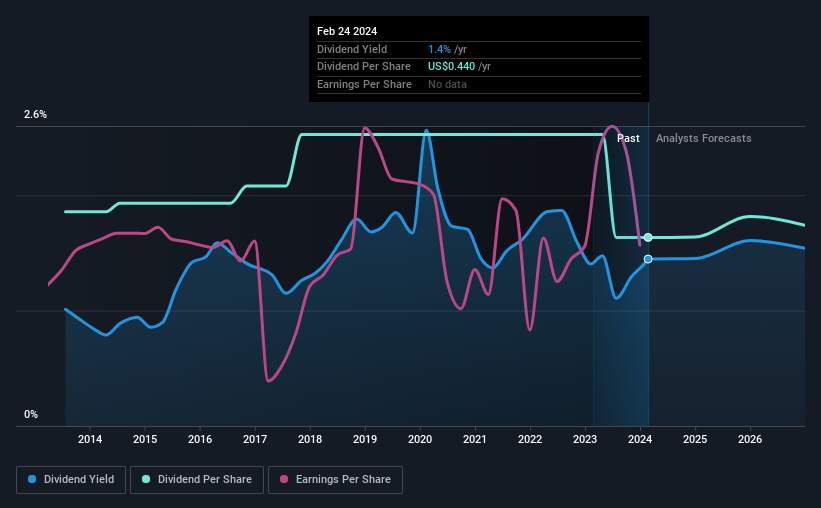It looks like BorgWarner Inc. (NYSE:BWA) is about to go ex-dividend in the next 4 days. The ex-dividend date occurs one day before the record date which is the day on which shareholders need to be on the company’s books in order to receive a dividend. The ex-dividend date is important as the process of settlement involves two full business days. So if you miss that date, you would not show up on the company’s books on the record date. Therefore, if you purchase BorgWarner’s shares on or after the 29th of February, you won’t be eligible to receive the dividend, when it is paid on the 15th of March.
The company’s next dividend payment will be US$0.11 per share, on the back of last year when the company paid a total of US$0.44 to shareholders. Based on the last year’s worth of payments, BorgWarner stock has a trailing yield of around 1.4% on the current share price of US$30.41. Dividends are a major contributor to investment returns for long term holders, but only if the dividend continues to be paid. As a result, readers should always check whether BorgWarner has been able to grow its dividends, or if the dividend might be cut.
View our latest analysis for BorgWarner
Dividends are typically paid out of company income, so if a company pays out more than it earned, its dividend is usually at a higher risk of being cut. BorgWarner paid out just 21% of its profit last year, which we think is conservatively low and leaves plenty of margin for unexpected circumstances. Yet cash flows are even more important than profits for assessing a dividend, so we need to see if the company generated enough cash to pay its distribution. Luckily it paid out just 23% of its free cash flow last year.
It’s positive to see that BorgWarner’s dividend is covered by both profits and cash flow, since this is generally a sign that the dividend is sustainable, and a lower payout ratio usually suggests a greater margin of safety before the dividend gets cut.
Click here to see the company’s payout ratio, plus analyst estimates of its future dividends.
Have Earnings And Dividends Been Growing?
Businesses with shrinking earnings are tricky from a dividend perspective. If earnings decline and the company is forced to cut its dividend, investors could watch the value of their investment go up in smoke. BorgWarner’s earnings per share have fallen at approximately 9.3% a year over the previous five years. When earnings per share fall, the maximum amount of dividends that can be paid also falls.
Another key way to measure a company’s dividend prospects is by measuring its historical rate of dividend growth. BorgWarner’s dividend payments per share have declined at 1.3% per year on average over the past 10 years, which is uninspiring.
To Sum It Up
Has BorgWarner got what it takes to maintain its dividend payments? BorgWarner has comfortably low cash and profit payout ratios, which may mean the dividend is sustainable even in the face of a sharp decline in earnings per share. Still, we consider declining earnings to be a warning sign. Overall, it’s hard to get excited about BorgWarner from a dividend perspective.
So while BorgWarner looks good from a dividend perspective, it’s always worthwhile being up to date with the risks involved in this stock. Case in point: We’ve spotted 2 warning signs for BorgWarner you should be aware of.
If you’re in the market for strong dividend payers, we recommend checking our selection of top dividend stocks.
Have feedback on this article? Concerned about the content? Get in touch with us directly. Alternatively, email editorial-team (at) simplywallst.com.
This article by Simply Wall St is general in nature. We provide commentary based on historical data and analyst forecasts only using an unbiased methodology and our articles are not intended to be financial advice. It does not constitute a recommendation to buy or sell any stock, and does not take account of your objectives, or your financial situation. We aim to bring you long-term focused analysis driven by fundamental data. Note that our analysis may not factor in the latest price-sensitive company announcements or qualitative material. Simply Wall St has no position in any stocks mentioned.
